Recovery of Microcrystalline Graphite from Quartz Using Magnetic Seeding
Abstract
1. Introduction
2. Materials and Methods
2.1. Materials
2.2. Magnetite Hydrophobization
2.3. Beneficiation Using Magnetic Seeding
2.4. Sedimentation Experiments
2.5. Zeta Potential Measurements
3. Theoretical Calculations
4. Results and Discussion
4.1. Characterization
4.2. Magnetite Hydrophobization
4.3. Beneficiation of Microcrystalline Graphite
4.4. Sedimentation Experiments
4.5. Zeta Potential Measurement and Inter-Particle Interaction Energy Analysis
5. Conclusions
Author Contributions
Funding
Acknowledgments
Conflicts of Interest
References
- Liang, L.; Zhang, T.; Peng, Y.; Xie, G. Inhibiting heterocoagulation between microcrystalline graphite and quartz by pH modification and sodium hexametaphosphate. Colloids Surf. A Physicochem. Eng. Asp. 2018, 553, 149–154. [Google Scholar] [CrossRef]
- Klunder, K.J.; Nilsson, Z.; Sambur, J.B.; Henry, C.S. Patternable Solvent-Processed Thermoplastic Graphite Electrodes. J. Am. Chem. Soc. 2017, 139, 12623–12631. [Google Scholar] [CrossRef] [PubMed]
- Guan, Z.; Shen, X.; Yu, R.; Wang, Z.; Chen, L. Chemical intercalation of solvated sodium ions in graphite. Electrochim. Acta 2016, 222, 1365–1370. [Google Scholar] [CrossRef]
- Xie, W.; Wang, Z.; Kuang, J.; Xu, H.; Yi, S.; Deng, Y.; Cao, T.; Guo, Z. Fixed carbon content and reaction mechanism of natural microcrystalline graphite purified by hydrochloric acid and sodium fluoride. Int. J. Miner. Process. 2016, 155, 45–54. [Google Scholar] [CrossRef]
- Lu, X.; Forssberg, E. Flotation selectivity and upgrading of Woxna fine graphite concentrate. Miner. Eng. 2001, 14, 1541–1543. [Google Scholar] [CrossRef]
- Bulatovic, S.M. Beneficiation of Graphite Ore. In Handbook of Flotation Reagents: Chemistry, Theory and Practice; Elsevier: Amsterdam, The Netherlands, 2015; Volume 3, pp. 163–171. [Google Scholar]
- Xie, W.; Zhu, X.; Yi, S.; Kuang, J.; Cheng, H.; Tang, W.; Deng, Y. Electromagnetic absorption properties of natural microcrystalline graphite. Mater. Des. 2016, 90, 38–46. [Google Scholar] [CrossRef]
- Wang, J.; Huang, J.; Yan, R.; Wang, F.; Cheng, W.; Guo, Q.; Wang, J. Graphene microsheets from natural microcrystalline graphite minerals: Scalable synthesis and unusual energy storage. J. Mater. Chem. A 2015, 3, 3144–3150. [Google Scholar] [CrossRef]
- Li, H.; Feng, Q.; Yang, S.; Ou, L.; Lu, Y. The entrainment behaviour of sericite in microcrystalline graphite flotation. Int. J. Miner. Process. 2014, 127, 1–9. [Google Scholar] [CrossRef]
- Feng, Q.; Chen, Y.; Zhang, G.; Lu, Y.; Ou, Y. Study on the purification of aphanitic graphite. Conserv. Util. Miner. Resour. 2003, 3, 20–22. [Google Scholar]
- Luo, L.; Tan, X.; Tian, J. Research progress of graphite purification. Chem. Ind. Eng. Prog. 2014, 33, 2110–2116. [Google Scholar]
- Ge, P.; Wang, H.; Zhao, J.; Xie, L.; Zhang, Q. Preparation of high purity graphite by an alkaline roasting–leaching method. New Carbon Mater. 2010, 25, 22–28. [Google Scholar] [CrossRef]
- Lu, X.J.; Forssberg, E. Preparation of high-purity and low-sulphur graphite from Woxna fine graphite concentrate by alkali roasting. Miner. Eng. 2002, 15, 755–757. [Google Scholar] [CrossRef]
- Zhang, L.; Fang, J.; Zhao, M.; Li, G. Development of aphanitic graphite purification. Chem. Ind. Eng. Prog. 2017, 36, 261–267. [Google Scholar]
- Wan, T.J.; Shen, S.M.; Siao, S.H.; Huang, C.F.; Cheng, C.Y. Using magnetic seeds to improve the aggregation and precipitation of nanoparticles from backside grinding wastewater. Water Res. 2011, 45, 6301–6307. [Google Scholar] [CrossRef] [PubMed]
- Parsonage, P. Principles of mineral separation by selective magnetic coating. Int. J. Miner. Process. 1988, 24, 269–293. [Google Scholar] [CrossRef]
- Feng, D.; Aldrich, C.; Tan, H. Removal of heavy metal ions by carrier magnetic separation of adsorptive particulates. Hydrometallurgy 2000, 56, 359–368. [Google Scholar] [CrossRef]
- Qiu, Y.; Xiao, X.; Ye, Z.; Guan, Z.; Sun, S.; Ren, J.; Yan, P. Research on magnetic separation for complex nickel deep removal and magnetic seed recycling. Environ. Sci. Pollut. Res. 2017, 24, 9294–9304. [Google Scholar] [CrossRef]
- Zhao, C.; Li, Y.; Wu, X.; Lu, D.; Han, S. Experimental investigation on aggregation of coal-fired PM10 by magnetic seeding. Chem. Eng. J. 2007, 133, 301–309. [Google Scholar] [CrossRef]
- Yiacoumi, S.; Rountree, D.A.; Tsouris, C. Mechanism of particle flocculation by magnetic seeding. J. Colloid Interface Sci. 1996, 184, 477–488. [Google Scholar] [CrossRef]
- Anastassakis, G.N. Separation of Fine Mineral Particles by Selective Magnetic Coating. J. Colloid Interface Sci. 2002, 256, 114–120. [Google Scholar] [CrossRef]
- Prakash, S.; Das, B.; Mohanty, J.K.; Venugopal, R. The recovery of fine iron minerals from quartz and corundum mixtures using selective magnetic coating. Int. J. Miner. Process. 1999, 57, 87–103. [Google Scholar] [CrossRef]
- Singh, S.; Sahoo, H.; Rath, S.S.; Sahu, A.K.; Das, B. Recovery of iron minerals from Indian iron ore slimes using colloidal magnetic coating. Powder Technol. 2015, 269, 38–45. [Google Scholar] [CrossRef]
- Lu, J.; Yuan, Z.; Liu, J.; Li, L.; Zhu, S. Effects of magnetite on magnetic coating behavior in pentlandite and serpentine system. Miner. Eng. 2015, 72, 115–120. [Google Scholar] [CrossRef]
- Lu, J.; Yuan, Z.; Wang, N.; Lu, S.; Meng, Q.; Liu, J. Selective surface magnetization of pentlandite with magnetite and magnetic separation. Powder Technol. 2017, 317, 162–170. [Google Scholar] [CrossRef]
- Yuan, Z.T.; Lu, J.W.; Liu, J.T.; Li, L.X.; Wang, S.Y. Enhancement of pentlandite surface magnetism and implications for its separation from serpentine via magnetic separation. Trans. Nonferrous Met. Soc. China 2017, 27, 204–210. [Google Scholar] [CrossRef]
- Gray, S.R.; Langberg, D.E.; Gray, N.B. Fine mineral recovery with hydrophobic magnetite. Int. J. Miner. Process. 1994, 41, 183–200. [Google Scholar] [CrossRef]
- Karapinar, N. Magnetic separation of ferrihydrite from wastewater by magnetic seeding and high-gradient magnetic separation. Int. J. Miner. Process. 2003, 71, 45–54. [Google Scholar] [CrossRef]
- Chinese GB Standards. GB/T 3521-2008: Method for Chemical Analysis of Graphite 2009; Standardization Administration of China: Beijing, China, 2009; 10p.
- Hu, Y.; Dai, J. Hydrophobic aggregation of alumina in surfactant solution. Miner. Eng. 2003, 16, 1167–1172. [Google Scholar] [CrossRef]
- Xu, Z.; Yoon, R. The Role of Hydrophobic Interactions in Coagulation. J. Colloid Interface Sci. 1989, 132, 532–541. [Google Scholar] [CrossRef]
- Israelachvili, J.N. Intermolecular and Surface Forces; Academic Press: Cambridge, MA, USA, 2011. [Google Scholar]
- Yu, Y.; Ma, L.; Xu, H.; Sun, X.; Zhang, Z.; Ye, G. DLVO theoretical analyses between montmorillonite and fine coal under different pH and divalent cations. Powder Technol. 2018, 330, 147–151. [Google Scholar] [CrossRef]
- Yao, J.; Yin, W.; Gong, E. Depressing effect of fine hydrophilic particles on magnesite reverse flotation. Int. J. Miner. Process. 2016, 149, 84–93. [Google Scholar] [CrossRef]
- Van Oss, C.J. Interfacial Forces in Aqueous Media; Marcel Dekker: New York, NY, USA, 2006. [Google Scholar]
- Van Oss, C.J.; Good, R.J. Surface Tension and the Solubility of Polymers and Biopolymers: The Role of Polar and Apolar Interfacial Free Energies. J. Macromol. Sci. Part A Chem. 1989, 26, 1183–1203. [Google Scholar] [CrossRef]
- Holuszko, M.E.; Franzidis, J.P.; Manlapig, E.V.; Hampton, M.A.; Donose, B.C.; Nguyen, A.V. The effect of surface treatment and slime coatings on ZnS hydrophobicity. Miner. Eng. 2008, 21, 958–966. [Google Scholar] [CrossRef]
- Liu, X.; Kaminski, M.D.; Guan, Y.; Chen, H.; Liu, H.; Rosengart, A.J. Preparation and characterization of hydrophobic superparamagnetic magnetite gel. J. Magn. Magn. Mater. 2006, 306, 248–253. [Google Scholar] [CrossRef]
- Shaikh, A.M.H.; Dixit, S.G. Role of Magnetite and Sodium Oleate in the High Gradient Magnetic Separation of Calcite Using Magnetic Coating of the Surface. J. Colloid Interface Sci. 1993, 155, 340–346. [Google Scholar] [CrossRef]
- Roonasi, P.; Yang, X.; Holmgren, A. Competition between sodium oleate and sodium silicate for a silicate/oleate modified magnetite surface studied by in situ ATR-FTIR spectroscopy. J. Colloid Interface Sci. 2010, 343, 546–552. [Google Scholar] [CrossRef]
- Carlson, J.J.; Kawatra, S.K. Factors affecting zeta potential of iron oxides. Miner. Process. Extr. Metall. Rev. 2013, 34, 269–303. [Google Scholar] [CrossRef]
- Barale, M.; Lefèvre, G.; Carrette, F.; Catalette, H.; Fédoroff, M.; Cote, G. Effect of the adsorption of lithium and borate species on the zeta potential of particles of cobalt ferrite, nickel ferrite, and magnetite. J. Colloid Interface Sci. 2008, 328, 34–40. [Google Scholar] [CrossRef]
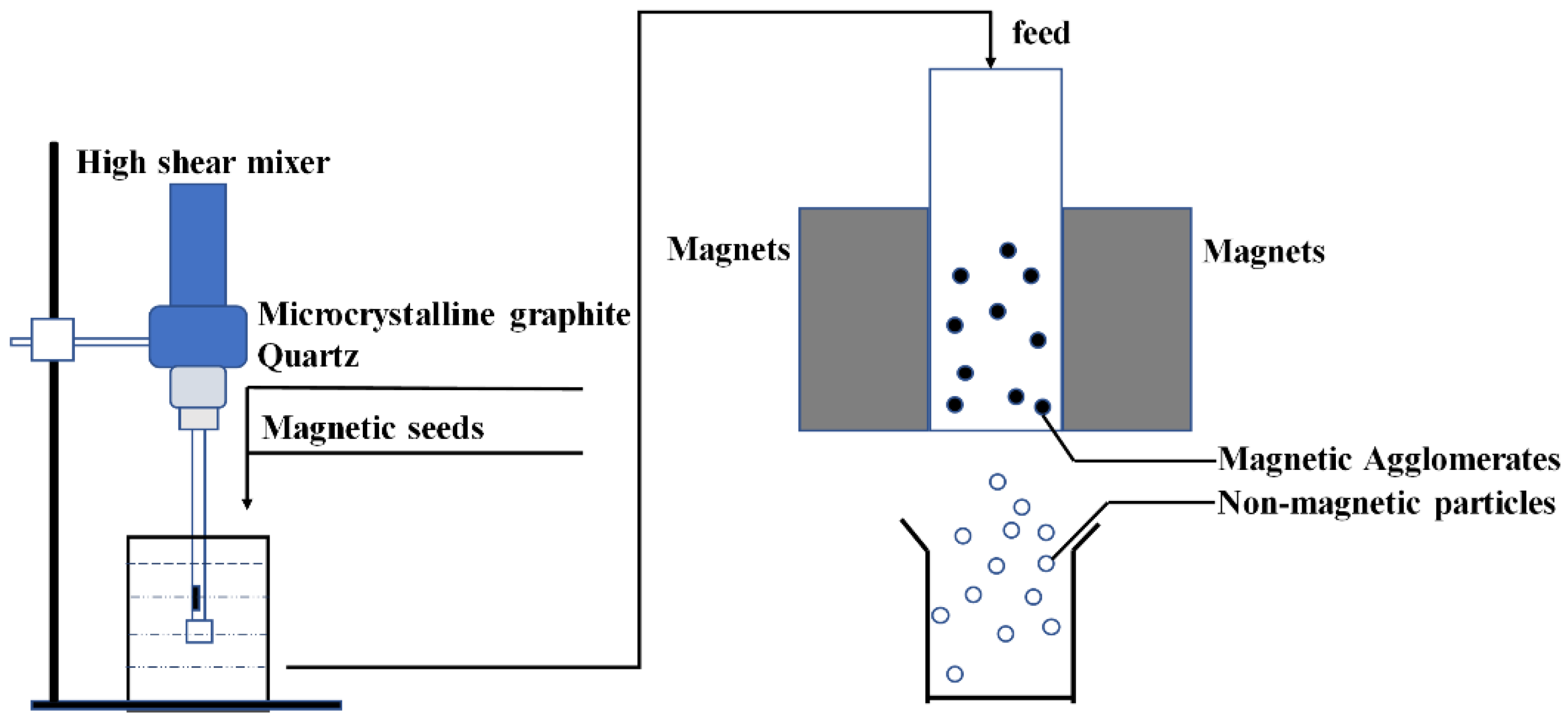
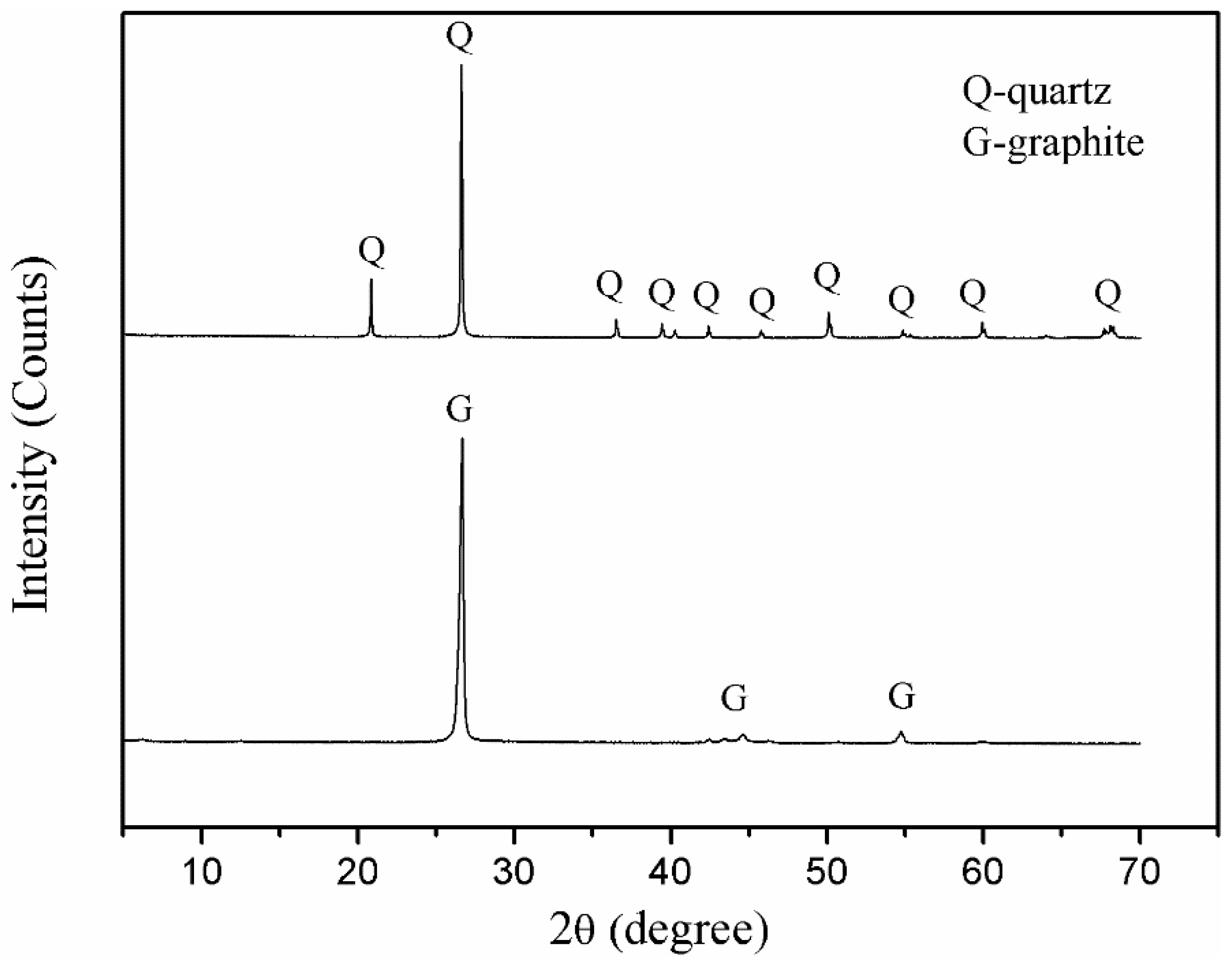
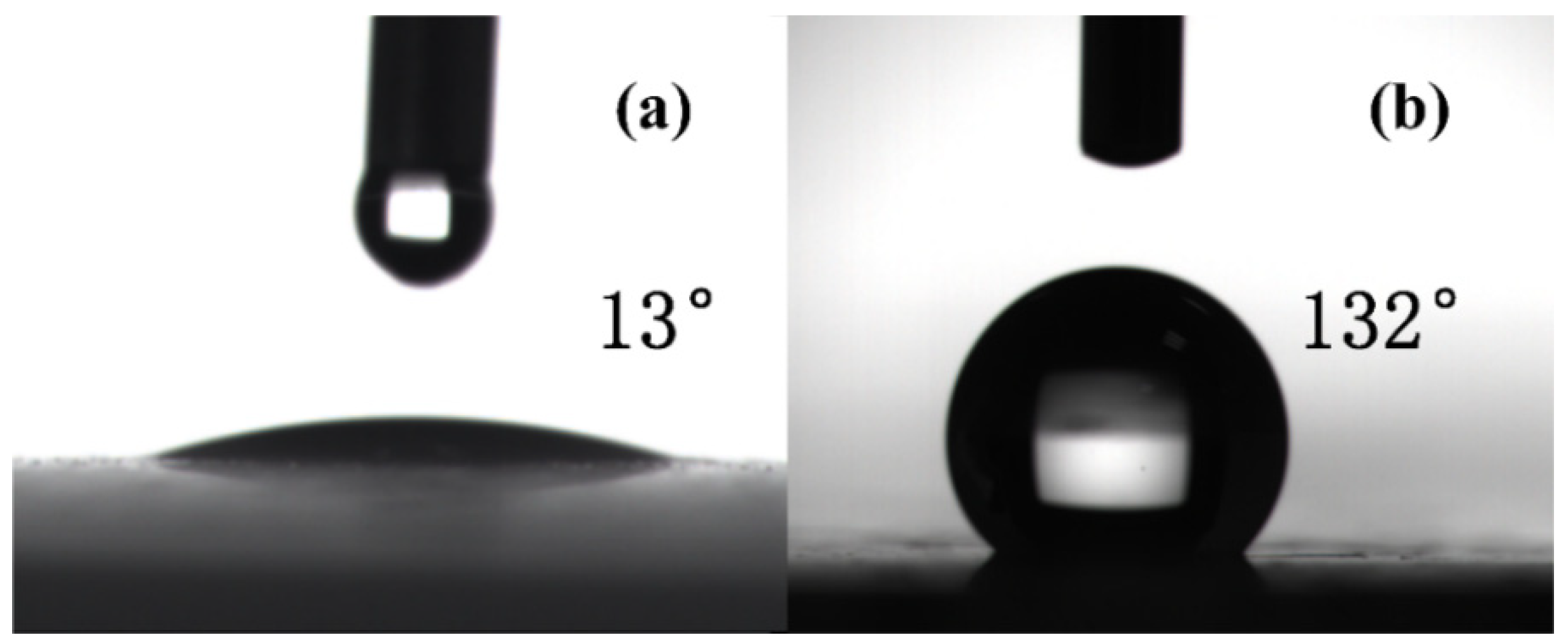
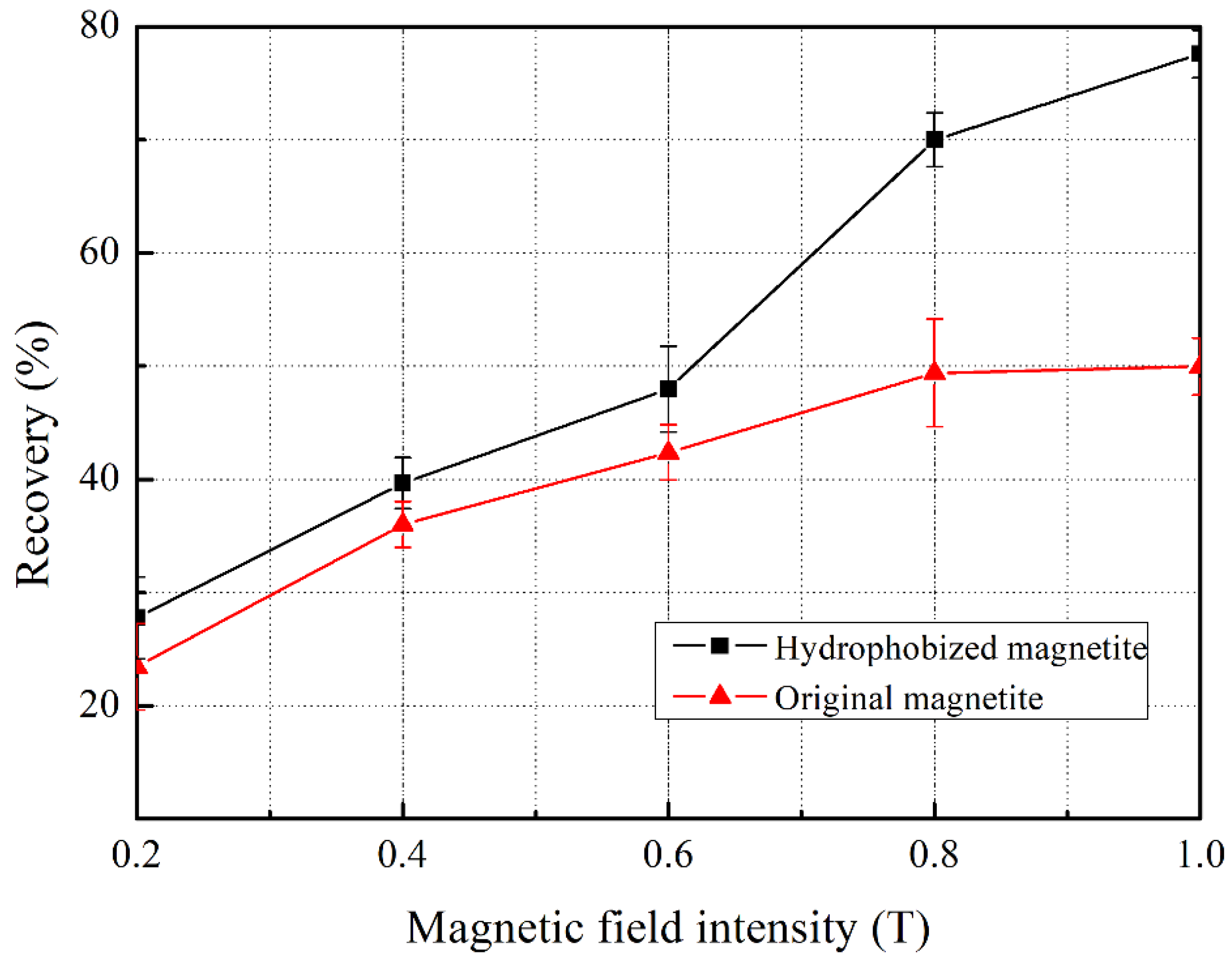
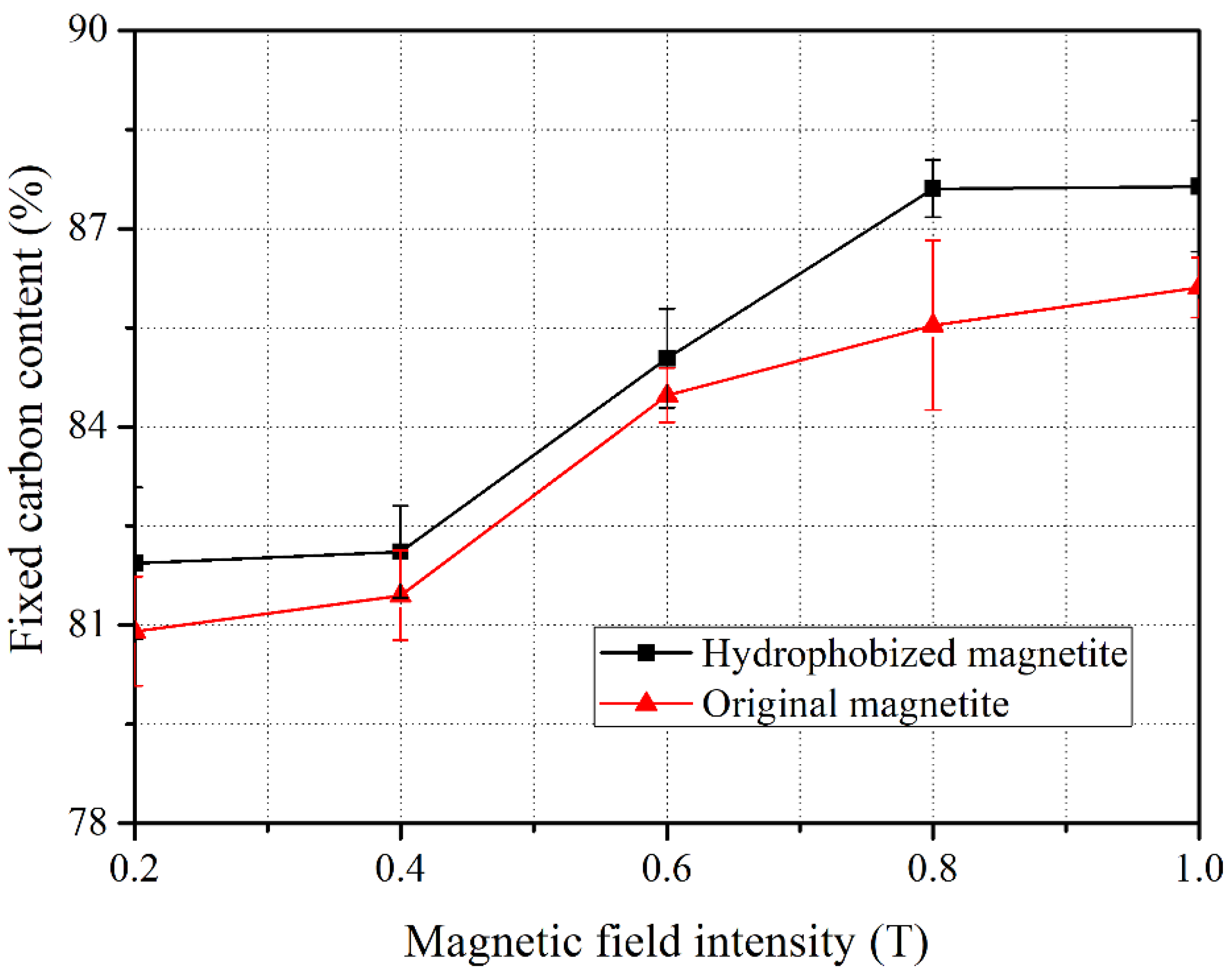

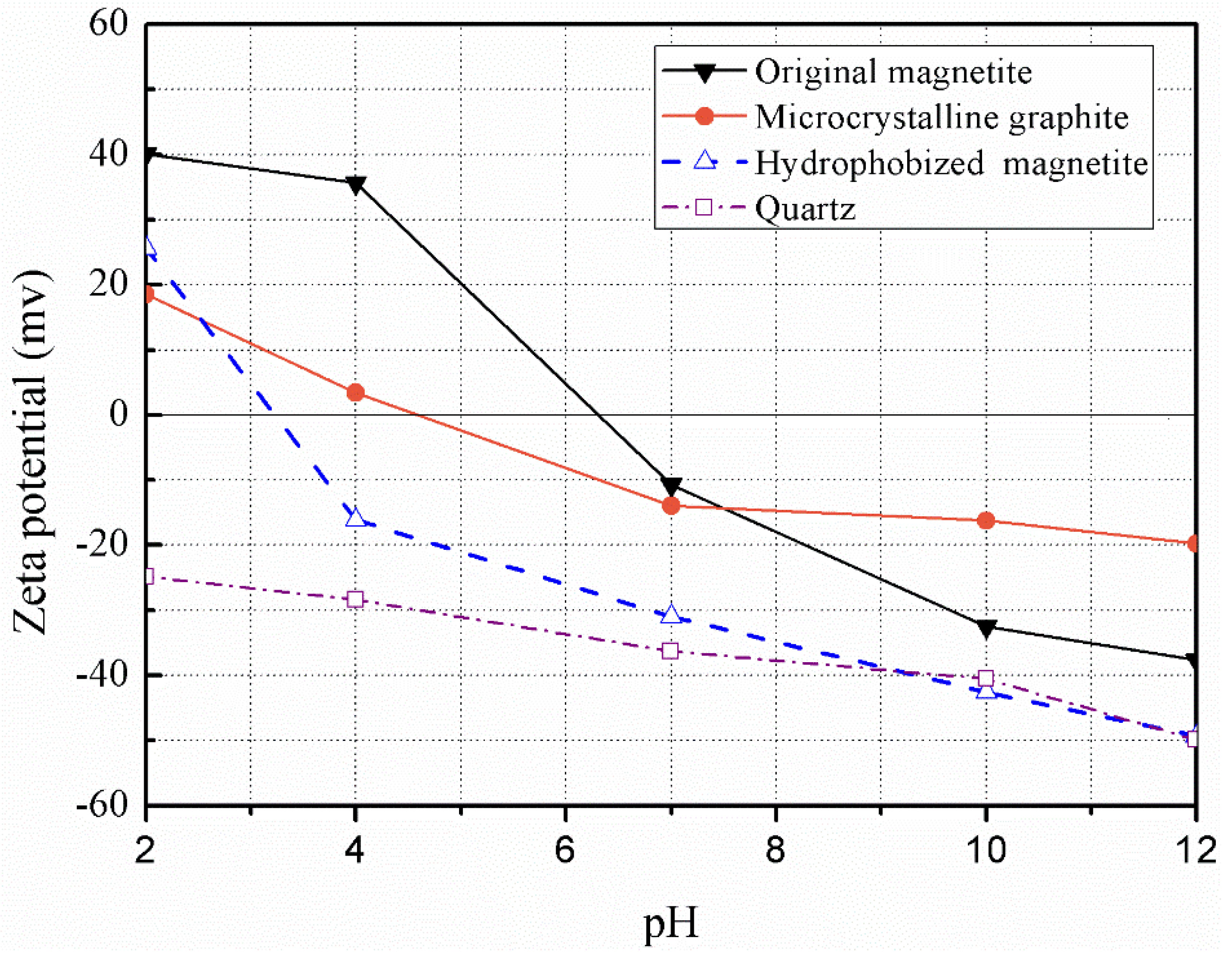
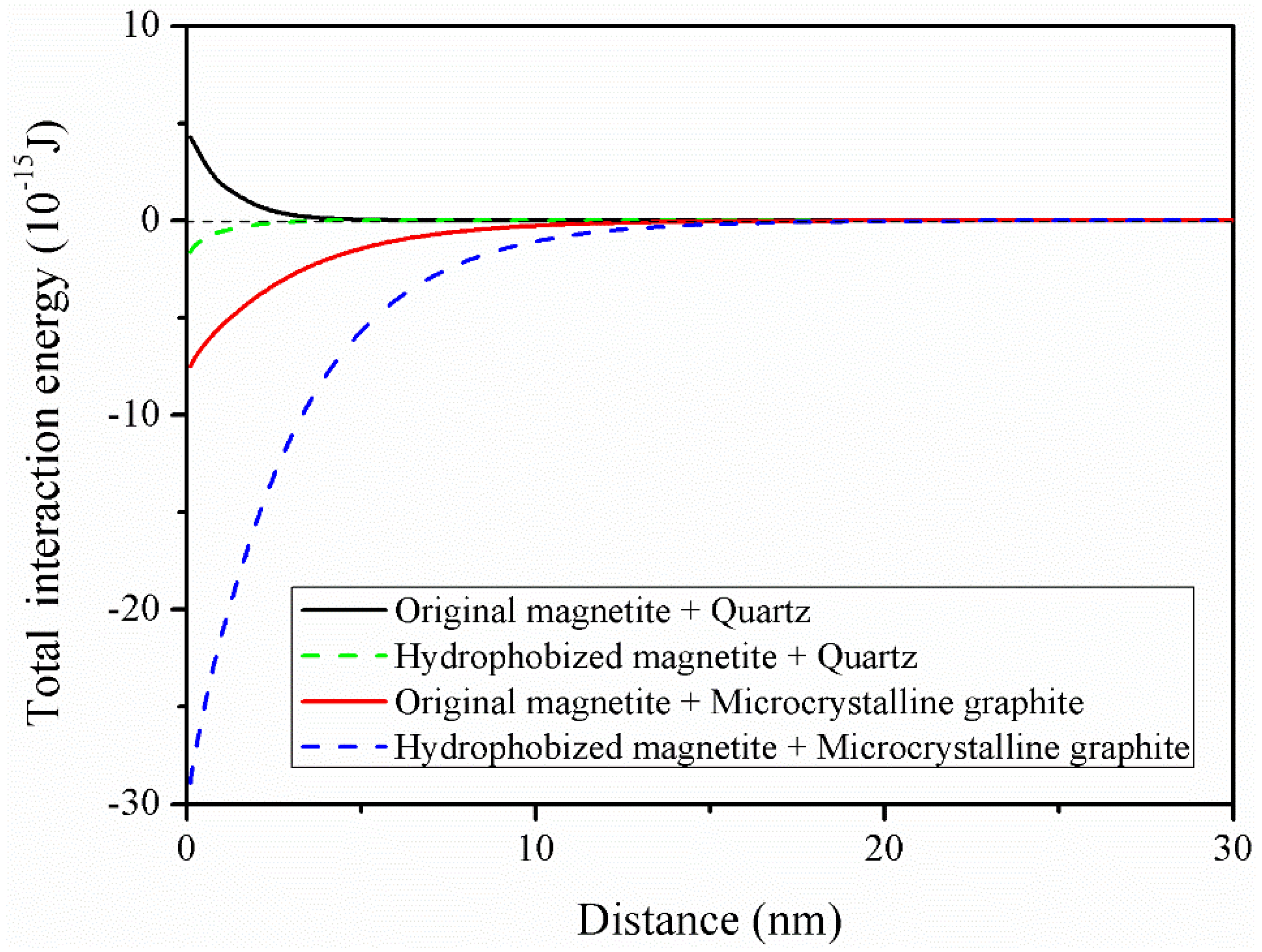
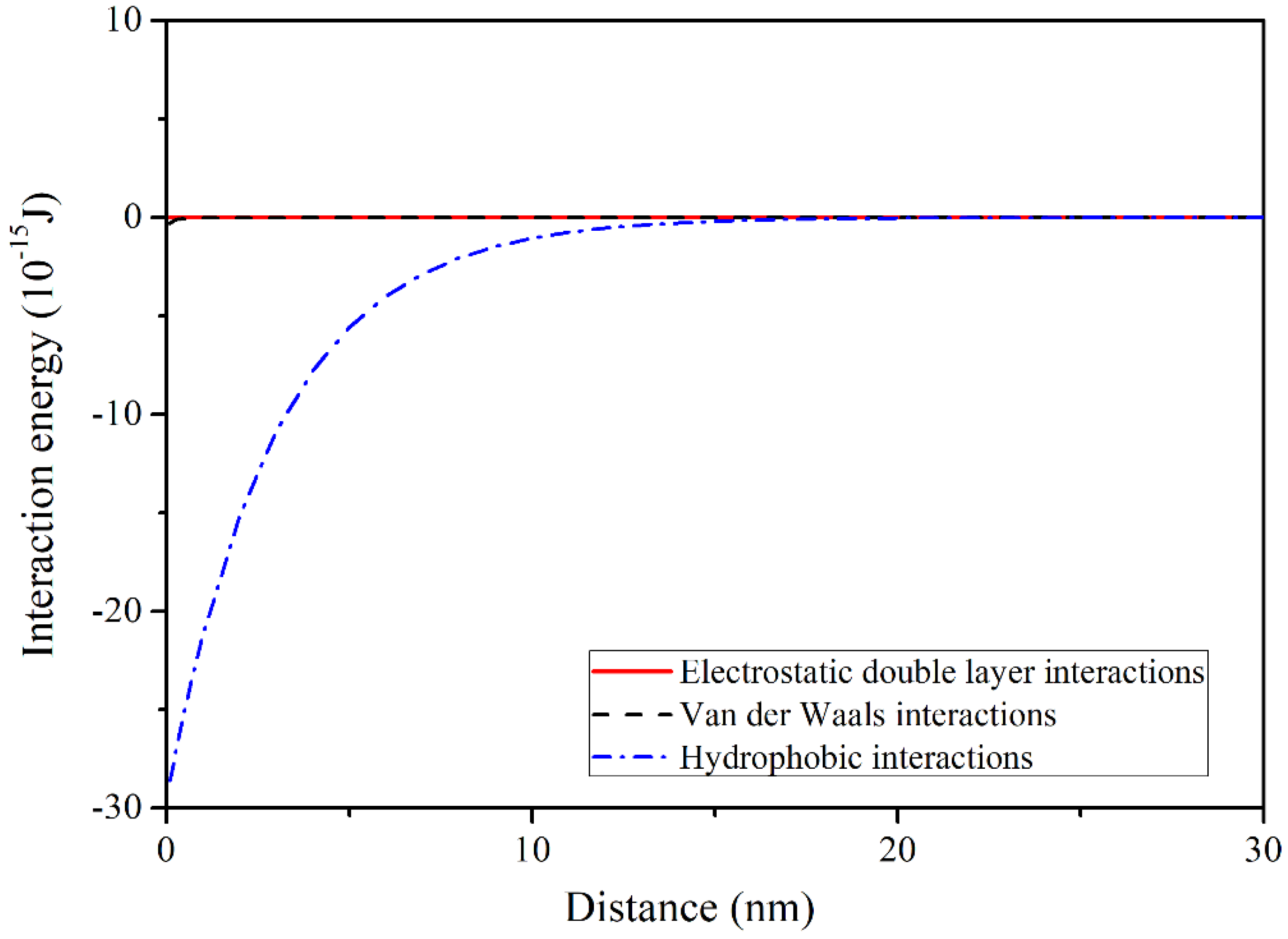
| Minerals | Contact Angle (Degree) | ||
|---|---|---|---|
| Distilled Water | Formamide | Diiodomethane | |
| Microcrystalline graphite | 97 | 65 | 38 |
| Quartz | 5 | 11 | 24 |
| Original magnetite | 13 | 10 | 16 |
| Hydrophobized magnetite | 132 | 110 | 105 |
| Minerals | Surface Energy (mJ/m2) | ||
|---|---|---|---|
| Microcrystalline graphite | 0.03 | 0.07 | 40.6 |
| Quartz | 0.34 | 56.62 | 46.50 |
| Original magnetite | 0.21 | 53.49 | 48.85 |
| Hydrophobized magnetite | 0.03 | 0.98 | 6.98 |
| Sample | Content (%) | ||||
|---|---|---|---|---|---|
| microcrystalline graphite | C | SiO2 | Fe2O3 | Al2O3 | Other |
| 96.00 | 1.79 | 0.69 | 0.52 | 1.00 | |
| quartz | SiO2 | Al2O3 | K2O | Other | |
| 97.93 | 0.86 | 0.57 | 0.64 | ||
| Mineral | D50, μm | D90, μm | Volume Average Diameter, μm |
|---|---|---|---|
| microcrystalline graphite | 6.26 | 14.25 | 10.72 |
| quartz | 7.69 | 18.74 | 14.31 |
| magnetite | 7.13 | 16.54 | 13.84 |
© 2019 by the authors. Licensee MDPI, Basel, Switzerland. This article is an open access article distributed under the terms and conditions of the Creative Commons Attribution (CC BY) license (http://creativecommons.org/licenses/by/4.0/).
Share and Cite
Hu, P.; Liang, L.; Peng, Y.; Yu, H.; Xie, G. Recovery of Microcrystalline Graphite from Quartz Using Magnetic Seeding. Minerals 2020, 10, 24. https://doi.org/10.3390/min10010024
Hu P, Liang L, Peng Y, Yu H, Xie G. Recovery of Microcrystalline Graphite from Quartz Using Magnetic Seeding. Minerals. 2020; 10(1):24. https://doi.org/10.3390/min10010024
Chicago/Turabian StyleHu, Pengfei, Long Liang, Yaoli Peng, Hesheng Yu, and Guangyuan Xie. 2020. "Recovery of Microcrystalline Graphite from Quartz Using Magnetic Seeding" Minerals 10, no. 1: 24. https://doi.org/10.3390/min10010024
APA StyleHu, P., Liang, L., Peng, Y., Yu, H., & Xie, G. (2020). Recovery of Microcrystalline Graphite from Quartz Using Magnetic Seeding. Minerals, 10(1), 24. https://doi.org/10.3390/min10010024






